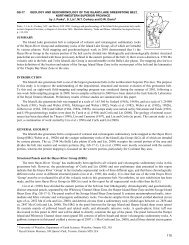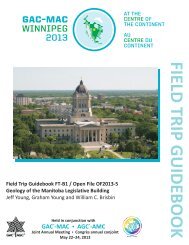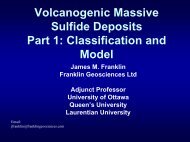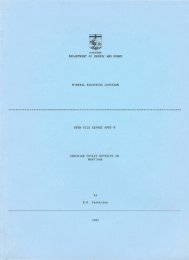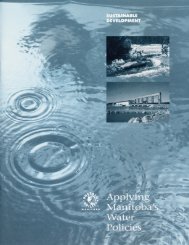Physical Volcanology, Hydrothermal Alteration and Massive ...
Physical Volcanology, Hydrothermal Alteration and Massive ...
Physical Volcanology, Hydrothermal Alteration and Massive ...
You also want an ePaper? Increase the reach of your titles
YUMPU automatically turns print PDFs into web optimized ePapers that Google loves.
are found throughout the lateral <strong>and</strong> vertical extent of this unit, making it a primeexploration target.The bedded quartz-crystal deposits are overlain by massive, very fine-grained ashflow tuff deposits which vary from 20 to 150 m in thickness. These units are composed ofzero to 2% small « 1 mm), broken <strong>and</strong> sliver-like quartz crystals in a quartz-rich matrix;it is not uncommon for these units to be intensely silicified <strong>and</strong> iron metasomatized. Thismassive unit is overlain by 5-35 m of bedded, fine-grained ash material which iscompositionally <strong>and</strong> chemically similar to the underlying massive ash flow tuffs. Themassive unit contains no known massive sulphide mineralization <strong>and</strong> lacks the pronouncedgeochemical zoning exhibited by the bedded deposits. In morphology these units aresimilar to those described by Busby-Spera (1984) from the Mineral King roof pendant <strong>and</strong>by Morton <strong>and</strong> Nebel (1983) from the Wawa area, <strong>and</strong> represent flow units deposited ina relatively shallow subaqueous environment.L SuccessionThis is a complex succession of rocks which range from quartz- <strong>and</strong> quartzplagioclase-bearingpyroclastic flow deposits through plagioclase-phyric lava flows <strong>and</strong>domes to sedimentary sequences. The entire succession ranges from 250 to 1200 m thickwith the domes, lava flows <strong>and</strong> dome related sediments <strong>and</strong> debris flow deposits makingup the bulk of the stratigraphy. The pyroclastic flow deposits form two distinct units, eachof which may represent a major pyroclastic eruption (caldera forming ?). The distributionof these pyroclastic rocks <strong>and</strong> their physical volcanology <strong>and</strong> alteration is currently thesubject of a doctoral thesis (Hudak, in progress). Work completed so far shows that theash flows associated with the first eruptive event are quartz- <strong>and</strong> plagioclase-crystal richwhereas the ash flows associated with the second eruptive period were dominantly quartzcrystal-rich <strong>and</strong> contain traces to 5% of K-spar crystals with associated K-spar in thegroundmass. These quartz-rich pyroclastic flows are the host rocks for the Sturgeon LakeMine, Lyon Lake <strong>and</strong> Creek Zone massive sulphide deposits. Feldspar-bearing lava flows<strong>and</strong> domes (up to 400 m thick <strong>and</strong> 3 km long), along with a variety of dome-derivedvolcaniclastic rocks <strong>and</strong> debris flow deposits, overlie the pyroclastic flow units. The domesoccur close to caldera margins <strong>and</strong> are believed to represent the last felsic eruptiveproducts associated with caldera formation. Locally iron formation (b<strong>and</strong>ed magnetite-12



